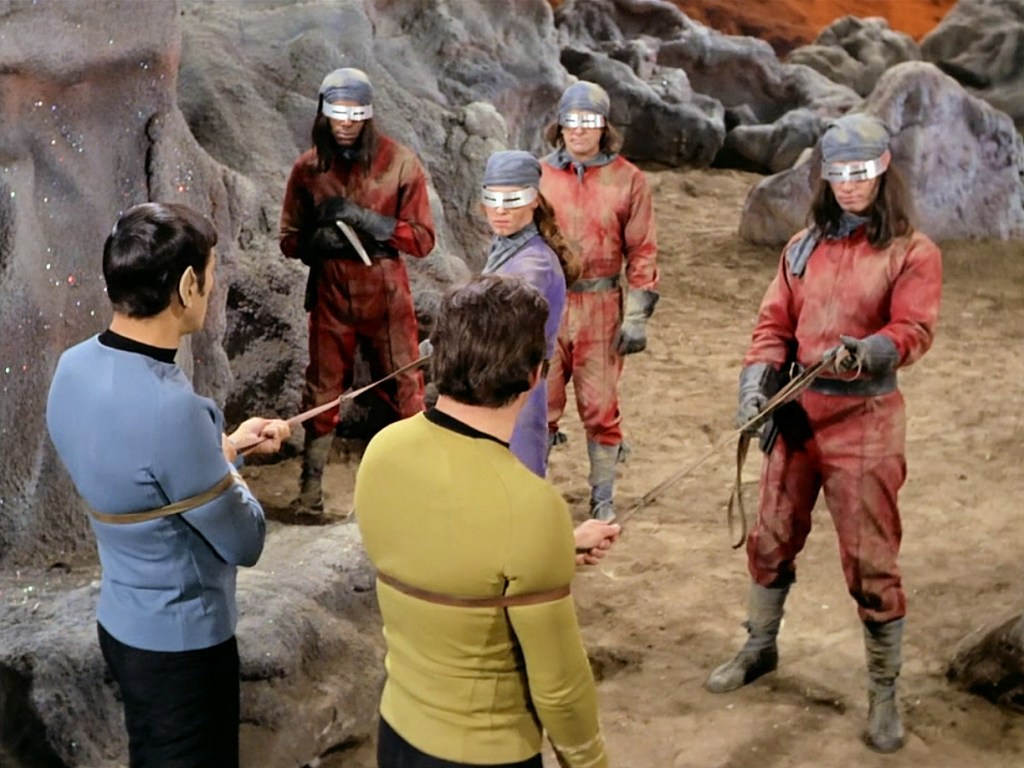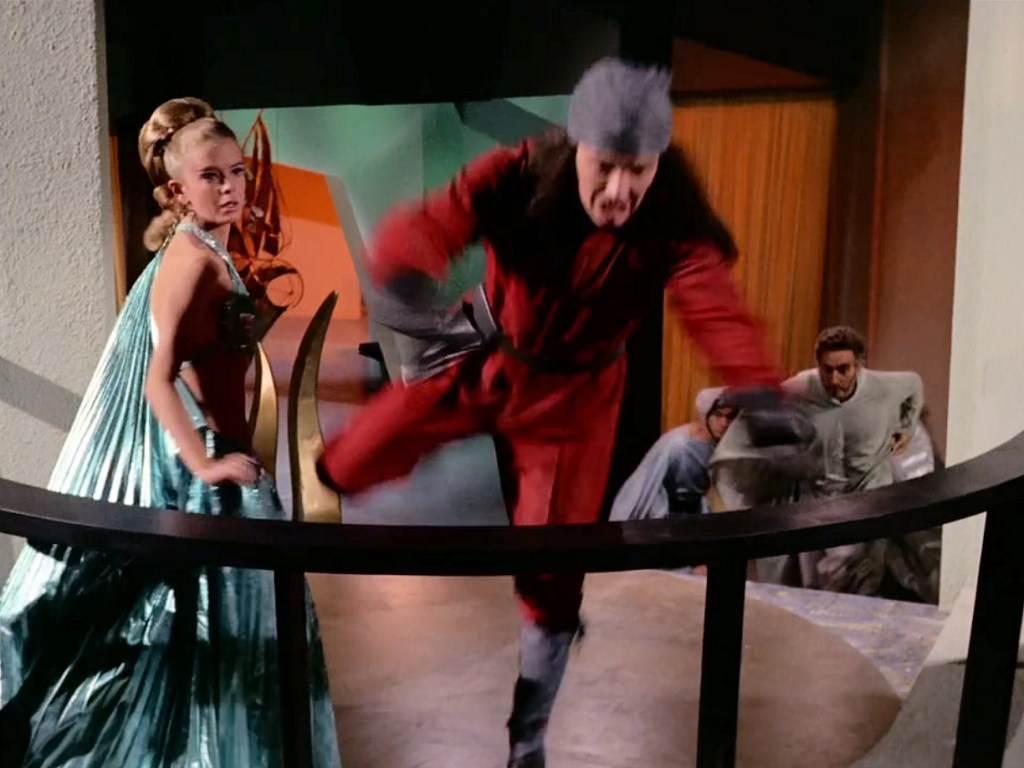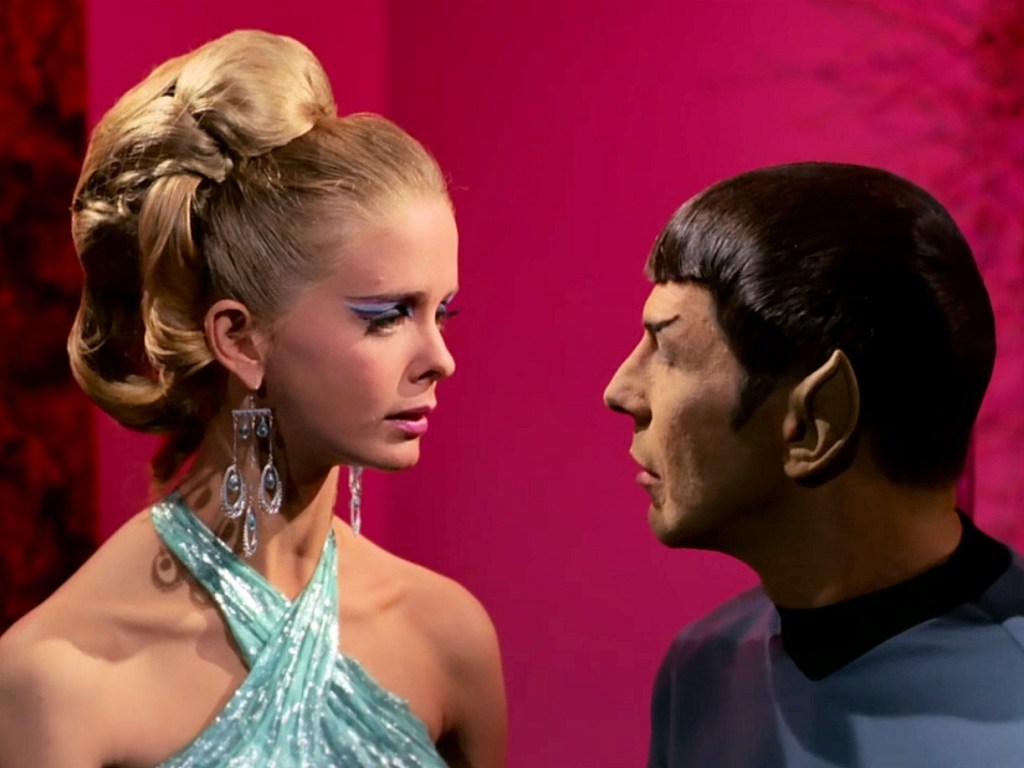(Note: If you haven’t read it yet, my introductory post on this Star Trek: The Original Series rewatch is a good place to start.)
Original Air Date: February 28, 1969
Crew Death Count: 0
Bellybuttons: 2 (Droxine and Vanna)
Like “Let That Be Your Last Battlefield,” “The Cloud Minders” is often criticized for presenting a social issue in a manner completely lacking in subtlety. While “The Cloud Minders” is not nearly as effective as “Battlefield,” I would argue the lack of subtlety is intended as a direct reflection of real life. This week, a botanical plague threatens to kill all vegetation on the planet Merak II, which is referred to but never seen in the episode. To prevent a complete collapse of Merak II’s food chain and climate (plant life is the planet’s sole source of oxygen), the Enterprise goes to the planet Ardana in search of zenite, the one substance that can treat the plague. The mission is complicated when Ardana’s zenite miners, referred to as troglytes, disrupt the zenite supply to protest harsh treatment by the planet’s overlords, who are residents of the floating city Stratos.

“The Cloud Minders” was heavily influenced by the 1927 film Metropolis, the early science-fiction film about conflict between the working class and wealthy business owners. The conflict on Ardana does parallel both the civil rights movement and the labor movement, two issues that are often viewed separately but which are, in fact, closely related. By its very name, Stratos (stratosphere) implies superiority over the troglytes on the planet’s surface. Residents of Stratos appear to have no actual work, so creating, viewing, and discussing art is their primary occupation; Ardana’s High Advisor (he’s high in the sky, get it?) Plasus (Jeff Corey) even introduces his daughter Droxine (Diana Ewing) as a “work of art.” Aesthetics and abstractions are of considerable importance on Stratos, emphasizing how far removed they are from the harsh physical labor performed by the miners. Droxine sounds bound for the privileged Ivy League when she says, “Stratos is for advisors and studiers.” Except for rare acts of sabotage by the troglytes (more on that later), Stratos is crime-free and stable. “The complete separation of toil and leisure has given Ardana this perfectly balanced social system,” Droxine says.

Of course, Ardana is only “perfectly balanced” for residents of Stratos, not the troglytes. “Troglyte” is short for troglodyte, a real term for people who live in caves or under the rock overhanging of a cliff. Racist Plasus describes the troglytes as “a conglomeration of inferior species,” though they look identical to occupants of Stratos. A subset of troglytes, referring to themselves as Disruptors, have begun agitating for better conditions and a fairer share of the rewards of all the hard work they’re performing. In real life, by the late 1960s, many blue collar workers were disillusioned not only with corporate decision-makers but with their own union leadership, who many felt had grown too close to management to be effective. Coal miners are a clear analogy to the troglytes of “The Cloud Minders.” When seventy-eight coal miners were killed in a mine explosion in late 1968 in West Virginia, workers were shocked when the president of the United Mine Workers of America defended the corporate owner of the mine and talked about the “inherent danger” of the work rather than offer consolation to grieving families. We can easily imagine Plasus offering a similar defense of zenite mining.

Early in the episode, one of the Disruptors’ acts of sabotage involves vandalism of an art exhibit on Stratos. Spock projects his lack of understanding of conditions on Ardana, when he asks, “But why do they destroy art forms? That is a loss to everyone.” Spock fails to understand his own privilege: the art is meaningless to the Disruptors, along with all troglytes, because they never get to enjoy it, much less have an opportunity to create their own art. Only later, after assessing the situation, does Spock understand that the Stratos/troglyte divide can’t be sustained indefinitely: “This troubled planet is a place of the most violent contrasts. Those who receive the rewards are totally separated from those who shoulder the burdens. It is not a wise leadership.”

The troglytes are an emotional bunch – one jumps to his death after being captured on Stratos, rather than face imprisonment or torture – and they appear incapable of advanced learning, presumably justifying Ardana’s system of inequity. It was (and remains) a common argument among segregationists: denied access to education and basic social infrastructure, an entire class of people proves unable to advance academically or professionally, creating a circular argument to continue denying them the very resources they need to achieve equality. McCoy, however, proves that zenite in its raw form is the real culprit; it emits an “odorless invisible gas that retards the intellectual functioning of the mind and heightens the emotion.” This must be one of McCoy’s finest moments, proving that mining zenite is exactly what prevents miners from ever becoming anything more. Zenite is widely used in the Federation, so it’s a mystery why this wasn’t already common knowledge. Black lung disease (also known as coal worker’s pneumoconiosis) offers a direct parallel to this episode’s zenite poisoning. (Learning disabilities caused by lead in drinking water offers another comparison, but this was less commonly understood in 1969: Lead was a common material in residential plumbing until 1986 and is still present in many U.S. communities.) Long-term exposure to coal dust causes inflammation and lesions in miners’ lungs, often becoming fatal. Like the Disruptors, coal miners used work stoppages to force attention to the issue. The West Virginia Black Lung Association was formed in January, 1969, only one month before “The Cloud Minders” aired, with the goal of obtaining compensation for miners suffering from black lung disease. As Jefferson Cowie describes in Stayin’ Alive: The 1970s and the Last Days of the Working Class: “By March 1969, forty thousand miners had stopped work – the largest strike for an occupational health issue in American history…” The Federal Coal Mine Health and Safety Act of 1969 was signed into law in December of that year partially to reduce the incidence rates of black lung disease. (No surprise: wearing a respirator is one of the recommended safety measures.) While the troglytes’ original motive is not health-related, the result is the same: a work stoppage that is understandable but still problematic for the ripple effect it has on a society in need of their product.

What matters now, however, is how the various parties respond to the information. By this point, we’re already questioning why Ardana is even tolerated as a Federation member. Toxic zenite fumes aside, didn’t the Federation already know about the harsh mining conditions? It’s hardly a secret; Kirk even describes having made a previous visit to the planet. Initially, Kirk is entirely mission-focused, hardly caring about the miners slaving away on the planet. When the troglytes disrupt the zenite he needs, he tells Plasus, “It is your council’s responsibility that nothing interferes with its obligation to another member of the Federation.” This makes the Federation sound like a protection racket, limiting membership to planets that can deliver a sufficient quantity of goods. The resulting power struggle between Plasus and Kirk is a complete breakdown of civil order, raising even bigger questions about Federation motives. When Plasus tries to force resumption of work by torturing Vanna (Charlene Polite), the leader of the Disruptors, Kirk expresses appropriate outrage. Kirk plans to end the torture by force, but turns meek when Plasus threatens to report Kirk’s interference to the Federation. Does this mean the Federation accepts torture? Does the non-interference directive apply equally to Federation members, and is there no loophole where torture is concerned? Plasus sounds like a “states’ rights” segregationist when he tells Kirk, “Your Federation orders do not entitle you to defy local governments.” The situation gets even worse when Plasus orders Kirk and Spock off the planet; after they return by stealth, Plasus threatens to kill them – again, we’re led to believe that the Federation will accept this cutthroat vigilantism as part of the cost of doing business. The Enterprise crew turns the tables soon enough, when Kirk, Spock, and Scott conspire to abduct Plasus and transport him into the zenite mines, where Kirk introduces him to the same hard labor the miners have endured all along. By the end of the episode, we have little hope of the Federation raising its standards: “I will tolerate absolutely no interference,” Plasus says. “You will not set foot here as long as I rule!”

Plasus initially refuses to provide the troglytes with masks that will filter out the zenite poison. “How can a mere filter accomplish what centuries of evolution have failed to do?” Plasus asks in a compete denial of basic science, mimicking anti-maskers in our own time. Plasus’ real motive, however, is fear of disruption to Ardana’s current hierarchy. Just as segregationists sought to deny Black Americans access to education in order to justify the myth of inferiority, so Stratos must maintain unhealthy working conditions to prevent the troglytes from demonstrating equal capabilities. Droxine tells Spock, “Here on Stratos we have completely eliminated violence,” at the exact moment Plasus secretly tortures Vanna. It’s much easier to maintain the illusion of peace when the only criminals are slave laborers desperate for freedom; Droxine accuses the Disruptors of being the only cause of violence in Stratos, refusing to acknowledge the violent living conditions that drove the troglytes to such extremes in the first place. Providing masks to the miners might put them on equal intellectual footing with Stratos’ inhabitants and end any justification for the institutionalized discrimination. “Are you afraid the filter masks will work?” Kirk asks Plasus. “Is that why you don’t want the troglytes to try them?”

We don’t get much sense of the troglytes themselves, as Vanna is the only one who gets much screen time. She is suitably determined, at one point abducting Kirk with the intent of holding him hostage “Until we have help in the mines and our homes are in the clouds.” She endures torture by Plasus rather than reveal information about other Disruptors. She calls to mind the imperial West’s destabilizing influence in the Middle East over oil, telling Kirk, “Interference breeds attack.” Vanna is a similar age as Droxine and, at one point, equally scandalously attired, inviting us to compare and contrast the two women’s personalities. Droxine generally seems as though she has just awakened from a nap, a far cry from the intense Vanna, who is both a labor agitator and a victim of zenite poisoning. Highly-cultured Droxine is drawn to mellow Spock – and Spock is equally drawn to her, resulting in the episode’s most bizarre writing. Droxine refers to Spock as a “very attractive officer,” while Spock describes her as “charming” and “lovely.” Spock goes so far as to openly discuss pon farr with Droxine, the subject so private that Spock threatened the lives of his colleagues before revealing it. (Spock’s implausible excuse: “Extreme feminine beauty is always disturbing.”) Kirk is attracted to the feistier (and fully awake) Vanna. What with being basically slave labor, Vanna is not particularly attracted to anyone in the episode, making Kirk’s attitude toward her even more condescending. When Vanna attacks the captain while he’s napping, Kirk quickly recovers and restrains her in the bed, telling her, “I find this rather enjoyable.”

Both “couples” are not meant to be, of course. Vanna never really takes to Kirk, perhaps because he’s willing to settle for giving the miners safety masks – a legitimate and important improvement in work conditions – while forgetting about the larger objective of equality. Spock and Droxine, in particular, are bound for dissolution. Spock is somewhat less taken with Droxine as he learns more about the harsh conditions the miners are subject to. “The surface of the planet is almost unendurable,” he says. “To restrict a segment of the population to such hardship is unthinkable in an evolved culture.” When Droxine questions the troglytes’ ability to understand anything beyond the basics of mining, asking, “What else can they understand, Mr. Spock?” he responds, “All the little things you and I understand and expect from life, such as equality, kindness, justice.”

Sadly, “equality, kindness, justice” are largely forgotten by the episode’s end. The Enterprise gets the zenite to save Merak II and the troglyte miners receive safety masks. Ardana’s equivalent of black lung disease is abolished, giving the troglytes equal intellectual potential of Stratos’ residents. We have no hope that anything else will change. Vanna and Plasus are still visibly hostile toward each other. In a pinch, couldn’t Merak II’s inhabitants have been evacuated while a more comprehensive solution was worked out? In his later years, Martin Luther King, Jr., dramatically expanded his vision beyond civil rights to include economic justice for all. He understood that Black Americans living on equal footing with the white working class of the late 1960s would still leave a nation of inequity. King urged an end to the Vietnam War to better direct resources to domestic social programs – losing the support of such good “Christians” as Billy Graham in the process – and initiating the Poor People’s Campaign to promote an Economic Bill of Rights that would guarantee, among other things, “a meaningful job at a living wage.” King’s death in 1968 left the Poor People’s Campaign in shambles. Similarly, the original ending of “The Cloud Minders” didn’t let viewers off the hook so easily: as originally written, the episode would have ended with Kirk putting the laborers and elites together at the negotiating table. When Kirk congratulates himself too quickly for merely beginning arbitration, McCoy reminds him that laborers and their families continue to suffer while their leaders debate: “Yes, but how many children will die in the meantime?” Instead, “The Cloud Minders” ends as class and economic conversations in our own society too often end: all solutions are final when the establishment’s hunger for products and profits is satisfied. The problem is that the establishment is never satisfied. It will always want more from us tomorrow, turning a blind eye to illness and hunger, and leaving room for only a few among the clouds.
Next: The Savage Curtain